Collection of materials relating to neuro-ophthalmology as part of the Neuro-Ophthalmology Virtual Education Library.
NOVEL: https://novel.utah.edu/
TO
Filters: Collection: "ehsl_novel_novel"
| Title | Creator | Description | Subject | ||
|---|---|---|---|---|---|
| 1 |
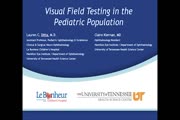 |
Visual Field Testing in the Pediatric Population | Lauren C. Ditta, MD | Visual field testing can be performed in the pediatric population with ease, however the proper technique for testing must be utilized and is tailored to each child's unique clinical situation and age. Confrontation visual field testing is a quick and easy; test that can yield a rough assessment of ... | Visual Field Testing; Pediatric; Confrontation Visual Field; Automated; Perimetry |
| 2 |
 |
Injury Prevention in the Visually Impaired | Jonathan Thomas; James Brian Davis; Amanda Dean Henderson | With an aging population in the US, the number of those with visual impairments is also rising. Visual impairments increase the risk of falls, injuries, and other deficiencies, but there are several potential strategies to prevent these injuries. Members of the healthcare team can help visually impa... | Fall; Injury Prevention; Low Vision Specialist; Visually Impaired |
| 3 |
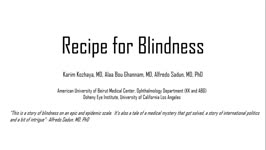 |
Optic Neuropathy: A Recipe for Blindness | Karim Kozhaya, MD; Alaa Bou Ghannam, MD; Alfredo Sadun, MD, PhD | An epidemic of blindness and peripheral neuropathy struck Cuba in the early 90s. By the end of 1993, 7% of the population was affected. Most patients were men and presented with sub-acute, painless, bilateral loss of vision. The etiology of the disease pondered local and international scientists, es... | Cuban Epidemic Optic Neuropathy; Leber's Hereditary Optic Neuropathy; Mitochondrial Insufficiency; Nutritional Optic Neuropathy; Pale Optic Nerve |
| 4 |
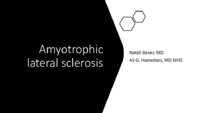 |
Amyotrophic Lateral Sclerosis (ALS) | Natali V. Baner, MD; Ali G. Hamedani, MD, MHS | PowerPoint providing an overview of the definition, clinical presentation and treatment of amyotrophic lateral sclerosis (ALS). | Amyotrophic Lateral Sclerosis (ALS) |
| 5 |
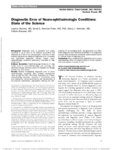 |
Diagnostic Error of Neuro-ophthalmologic Conditions: State of the Science | Leanne Stunkel, MD; David E. Newman-Toker, MD, PhD; Nancy J. Newman, MD; Valérie Biousse, MD | Diagnostic error is prevalent and costly, occurring in up to 15% of US medical encounters and affecting up to 5% of the US population. One-third of malpractice payments are related to diagnostic error. A complex and specialized diagnostic process makes neuro-ophthalmologic conditions particularly vu... | Diagnostic Errors |
| 6 |
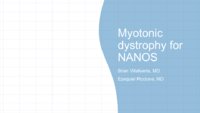 |
Myotonic Dystrophy | Brian Villafuerte, MD, Ezequiel Piccione, MD | Presentation covering an overview of myotonic dystrophy. | Myotonic Dystrophy |
| 7 |
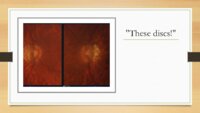 |
Tilted-Disc Syndrome (TDS) - Understanding the Basics | Ahmed Alshaikhsalama; Melanie Truong-Le | This submission is a powerpoint summarizing the literature on a poorly understood disorder known as Tilted Disc Syndrome (TDS). Delving into the fundamental aspects of TDS, this resource meticulously digests complex medical literature to inform readers on the epidemiology, risk factors, complication... | Coloboma; Inferior Crescent; Tilted Disc Syndrome |
| 8 |
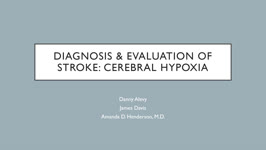 |
Diagnosis and Evaluation of Stroke: Cerebral Hypoxia | Danny Alevy; James Brian Davis; Amanda Dean Henderson | Neurons are particularly vulnerable to oxygen deprivation. Cerebral hypoxia can be caused by arterial thrombosis, embolism, hypoperfusion, cervical artery dissection, or cryptogenic causes. About 1/3 of ischemic strokes are from cryptogenic causes. Embolic strokes are the next most common (20-30%), ... | Atherosclerosis; Cerebral Hypoxia; Cervical Artery Dissection; Cryptogenic Ischemia; Embolism; Hypoperfusion; Ischemia; Stroke; Thrombosis |
| 9 |
 |
Afferent Visual Pathway Disorders: Typical vs Atypical Optic Neuritis | Carmen Chan, FRCP, FRCOphth, FRCSEd(Ophth), FHKAM(Ophthalmology) | Discussion of typical vs atypical optic neuritis. | Optic Neuritis |
| 10 |
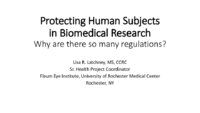 |
Protecting Human Subjects in Biomedical Research | Lisa R. Latchney, MS, CCRC | PowerPoint discussion of the history and development of ethics regulations in health research. | Ethical Issues in Research; Consent |
| 11 |
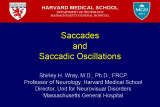 |
Saccades (Guest Lecture) | Shirley H. Wray, MD, PhD, FRCP | The video of the normal eye movement examination was made with the assistance of Dr. Terrence Millette, a neurologist and former Fellow with me in 1985-1986. Introduction to the Saccadic System Saccades are fast eye movements that bring the image of an object of interest onto the fovea. They consist... | Normal Eye Movements; Examination, Ocular; Saccades; Optokinetic Nystagmus Drum (OKN Drum); Pursuit; Ocular Motility |
| 12 |
 |
Optochiasmal Tuberculoma | Jeanie Paik, MD; Rudrani Banik, MD | PowerPoint of case of chiasmal tuberculoma causing bitemporal defect in patient with tuberculosis on RIPE treatment; case history, differential diagnosis and treatment discussed. | Chiasmal Disorder; Chiasmal Tuberculoma; Bitemporal Visual Field Defect; Ethambutol Optic Neuropathy |
| 13 |
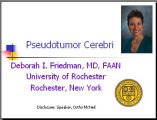 |
Pseudotumor Cerebri | Deborah I. Friedman, MD | This one hour presentation on Pseudotumor cerebri is the first in a series of Neuro-Ophthalmology All Star Grand Rounds. The videolecture is accompanied by written material and is intended as a teaching tool for medical residents. Studies in the 1980s calculated the annual incidence of pseudotumor c... | Pseudotumor Cerebri; Idiopathic Intracranial Hypertension |
| 14 |
 |
Giant Cell Arteritis: Diagnostic Prediction Models, Temporal Artery Biopsy and Epidemiology | Edsel Ing MD, PhD FRCSC MPH CPH MIAD MEd MBA, | Giant cell arteritis (GCA) is the most common primary vasculitis in the elderly and can cause irreversible blindness, aortitis, and stroke. Diagnostic confirmation of GCA usually entails temporal artery biopsy (TABx) - a time-consuming and invasive test, or ultrasound. The primary treatment of GCA i... | Giant Cell Arteritis; Diagnostic Prediction Model; Epidemiology; Temporal Artery Biopsy; Differential Diagnosis |
| 15 |
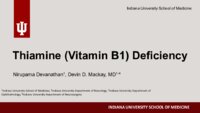 |
Thiamine (Vitamin B1) Deficiency (Presentation) | Nirupama Devanathan; Devin D. Mackay, MD | Overview of thiamine deficiency and its neuro-ophthalmic manifestations with an illustrative case example and discussion of clinical presentation, relevant biochemistry, testing, risk factors, and treatment. Corresponding Video: https://collections.lib.utah.edu/details?id=2297569 | Thiamine; Upbeat Nystagmus; Nutritional Optic neuropathy; Wernicke Encephalopathy |
| 16 |
 |
Other Trigeminal Autonomic Cephalalgias (TACs) | Jihad Yaqoob Ali Al Kharbooshi; Tommy Lik Hang Chan; J. Alexander Fraser | In this narrated slideshow, we review the pathophysiology, epidemiology, differential diagnosis, diagnostic criteria, subtypes, and management of the other trigeminal autonomic cephalalgias (cluster headache and the SUNHA syndromes). It is a companion to our earlier slideshow, "Trigeminal autonomic ... | Indomethacin; SUNA; SUNCT; SUNHA; TAC; Trigeminal Autonomic Cephalalgia |
| 17 |
 |
Unilateral Oculomotor Nerve Palsy Secondary to Internal Carotid Artery Aneurysm Without Pupil involvement: A Case Report | Danilo Andriatti Paulo; Richard J Blanch | Acquired oculomotor palsies (OMP) can result from numerous factors. The most common causes are presumed microvascular, trauma, compressive neoplasm, postneurosurgery and compression from aneurysm.1,2 ONP caused by internal carotid artery (ICA) aneurysm is a common clinical manifestation suggesting i... | Unilateral Oculomotor Nerve Palsy; Internal Carotid Artery Aneurysm; Pupil Involvement; Oculomotor Nerve Palsy; Secondary Oculomotor Nerve Palsy |
| 18 |
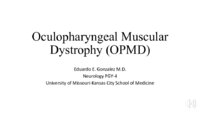 |
Oculopharyngeal Muscular Dystrophy (OPMD) | Eduardo Gonzalez; Sean Gratton | This is a brief review of Oculopharyngeal Muscular Dystrophy. It includes a review of the background, pathophysiology, epidemiology, diagnosis, and management of the disorder. The key clinical features including ptosis and dysphagia are reviewed in detail. | Chronic Progressive External Ophthalmoplegia; Dysphagia; Muscular Dystrophy; Myasthenia Gravis; Oculopharyngeal Muscular Dystrophy; Ptosis |
| 19 |
 |
Ethambutol Optic Neuropathy | Hailey Mair, BS; Padmaja Sudhakar, MD | This is a PowerPoint slide describing ethambutol induced optic neuropathy and it elaborates on mechanism and vulnearble population. | Ethambutol; Tuberculosis; Optic Neuropathy |
| 20 |
 |
How to Submit an IRB Application | Elizabeth Frakes, MLIS, AHIP | A general outline of the steps involved in submitting an IRB application for research. | Institutional Review Board (IRB) |
| 21 |
 |
High Yield Secondary Headaches | Kathleen B. Digre | Lecture and case reports relating to secondary headaches. | Primary Headache; Secondary Headache |
| 22 |
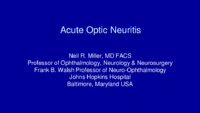 |
Acute Optic Neuritis | Neil R. Miller, MD, FACS | Overview of acute optic neuritis. | Optic Neuritis |
| 23 |
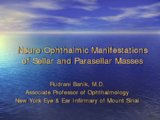 |
Neuro-Ophthalmic Manifestations of Sellar and Parasellar Masses | Rudrani Banik, MD | Neuroanatomy of the Chiasm. | Parasellar Masses |
| 24 |
 |
The Mental Status Examination - Cognitive | James R. Bateman, MD, MPH; Victoria S. Pelak, MD | Introduction to the cognitive mental status examination. See accompanying videos: Executive function: https://collections.lib.utah.edu/ark:/87278/s6bw1rp1, Limb-Kinetic apraxia: https://collections.lib.utah.edu/ark:/87278/s63c084b, Ideomotor apraxia: https://collections.lib.utah.edu/ark:/87278/s674... | Mental Status; Cognitive Function |
| 25 |
 |
The Mental Status Examination | James R. Bateman, MD, MPH; Victoria S. Pelak, MD | Introduction to the mental status examination. See accompanying videos: Executive function: https://collections.lib.utah.edu/ark:/87278/s6bw1rp1, Limb-Kinetic apraxia: https://collections.lib.utah.edu/ark:/87278/s63c084b, Ideomotor apraxia: https://collections.lib.utah.edu/ark:/87278/s67410xj | Mental Status |
